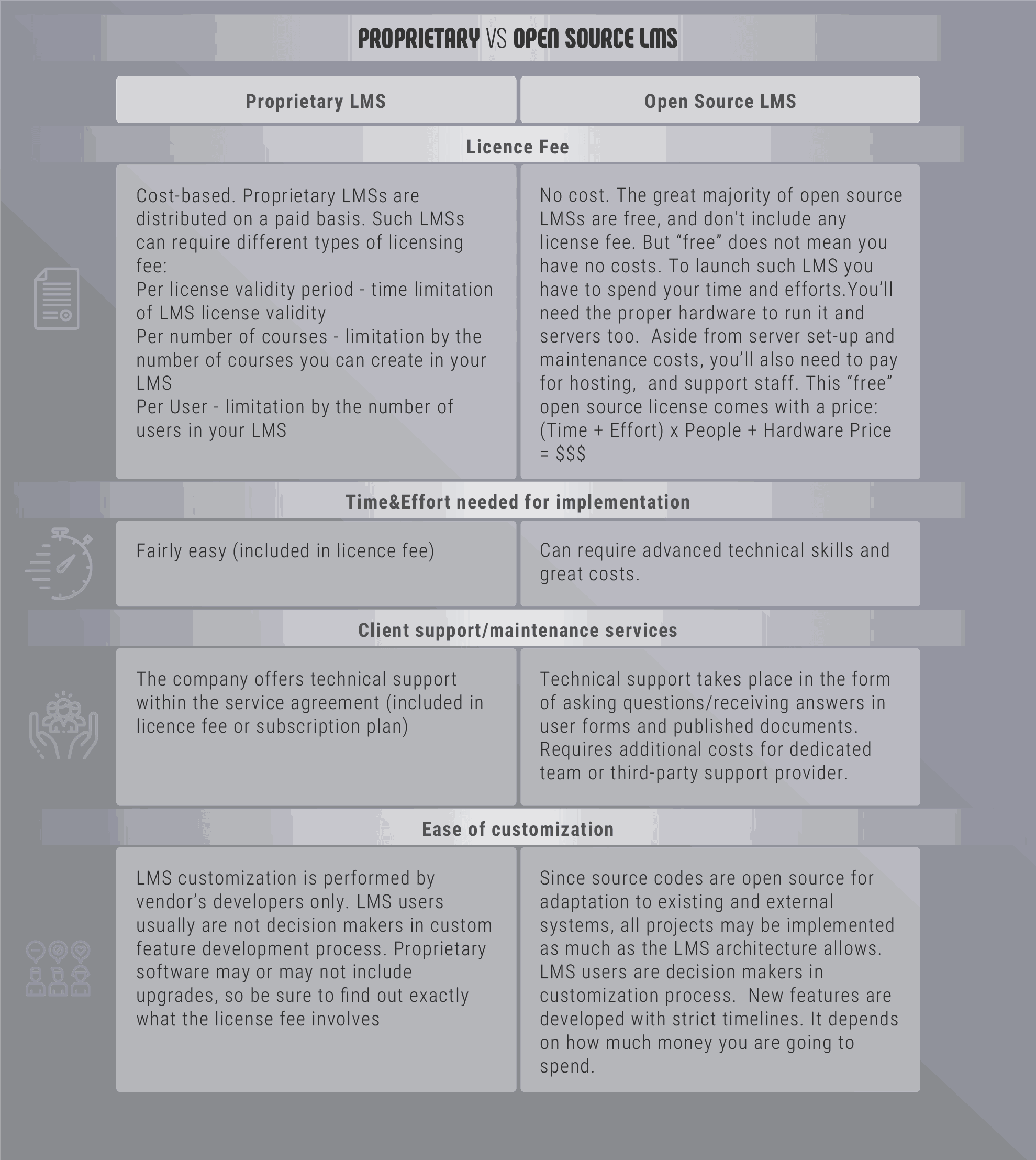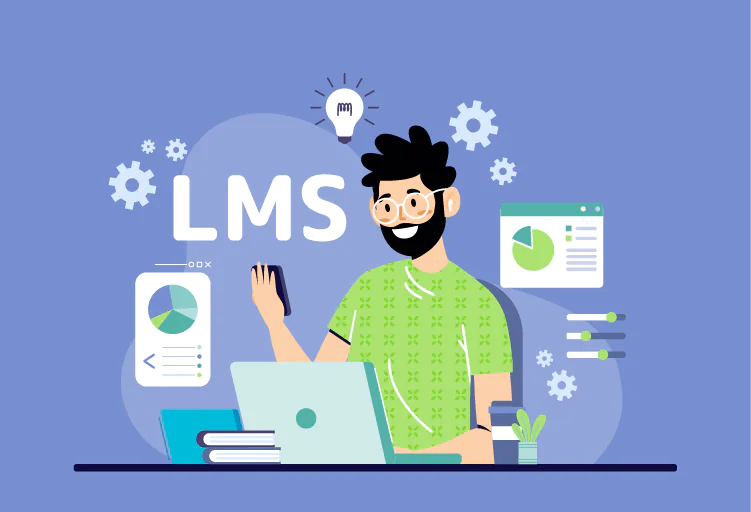The last two decades have been monumental for the eLearning industry. With bright minds willing to make learning as easy and accessible as possible, there has been a surge in various technologies.
One of these creations that brought about a paramount change in the eLearning community includes an LMS. Learning Management System or an LMS is a software solution that combines complex databases and digital frameworks.
It allows users to share, create, distribute, manage, and track learning content through an efficient platform. The wide applicability of the software along with the convenience of the platform has gained quite a lot of popularity over time.
The primary purpose of LMS software is to allow users to deploy, track, and manage training initiatives. However, this can vary depending on the individual needs of the company, their objectives, training strategy, and the results they want the LMS to achieve.
Typically, companies use it to upload educational material on the platform and make it accessible to remote users. This way, they don’t have to be physically present to take advantage of the training.
It is similar to a large silo where you can save and track the information you want to make accessible to others. You can decide who can get access. Generally, the people who register or qualify for the training are provided with a login ID and a password to use the LMS.
What makes this technology extremely convenient is the fact that users can access the LMS from anywhere and at any time.
On the other hand, there are some learning management systems that require the software to be installed on the computers of all the users. These are called self-hosted LMS. We will discuss that later on in the article.
Who Uses an LMS
LMS platforms are not limited to just one industry or customer type. They are used around the world for various types of corporate and academic learning. Regardless of the deployment option it applies, an LMS is used by two kinds of user-roles.
Learners
Anyone who is on the receiving end of the training or eLearning is classified as a learner. They use the software to gain access to the course materials, to upload assignments, to get evaluations, and to track their progress on the training.
Administrators/Trainers/Teachers
On the other end of eLearning there are administrators. They are responsible for creating, uploading, and managing the course materials, giving evaluations, tracking the trainees’ performance, and assigning learning plans to specific learner groups.
Features of an LMS
As mentioned before, the LMS market has certainly expanded in the past few years. There are hundreds of vendors offering a different LMS platforms, meaning you can find ones with unique features.
However, there are a few components that most LMS systems share. These include:
- Multichannel access, where users are able to access the material on from any device.
- Course management is the primary component of an LMS, allowing admins to create and upload course materials.
- Document management offers both learners and admins to upload, download, and create documents.
- Scheduling features allow users to create and stay up to date with the training schedule, test dates, etc.
- Tracking features make tracking progress easy. Users can upload or check test scores, feedback, and overall performance reports.
- eLearning assessment tools support various methods that allow admins to assess the learner’s assignments and tests while also generating overview reports.
- Gamification features in the form of eBadges, points, and leaderboards actively engage users and motivate them just like rewards do.
- Compliance support refers to the LMS’s ability to share information through compliance with other eLearning software. Look for platforms that support eLearning standards such as SCORM and Tin Can API.
- Social tools such as notifications, message boards, and discussion portals allow learners and administrators to share knowledge with other learners. They are also convenient for communicating.
- Whitelabeling allows the administrators to personalize the platform and create content that aligns with the company’s branding.
Besides these, there are some other features that you should look for in an LMS platform:
Responsive Design
An efficient LMS platform should be multiplatform-friendly. This enables users to access the course materials from any device. This means that whether you’re using a smartphone, a laptop, a tablet or a desktop, you should be able to access all tools easily.
Having a responsive design means the platform will automatically adjust itself according to the device it is accessed from. For example, if you open the LMS on your phone, it will shrink the display to accommodate the phone’s screen size.
User-Friendliness
Learning how to use an LMS can already have a learning curve for some people. There is no point in using a platform that requires additional training.
It’s important that users at both ends can utilize the platform to the best of its abilities without spending too much time trying to figure it out.
Types of LMS Platforms
LMS platforms fall into three distinct types. These include:
Employee LMS
Conglomerates or multinational companies use LMS platforms to gauge their employees’ performance, KPIs and professional development. The major purpose of an LMS for large enterprises is the distribution of online training programs.
The focus of such an LMS is to train the company’s employees. The tools of the platform make it easy to train and bring new employees onboard, ensure compliance training, and track their career development over the course of their employment.
Extended Enterprise LMS
Some companies also use the LMS to maintain a consistent connection between sales, suppliers, warehouses, franchises, and business teams. This allows everyone to be kept in the loop when it comes to launching new products, inventory management, and other internal correspondence.
Big manufacturing companies also use extended enterprise LMS platforms to train their suppliers.
According to Software Advice here are 4 of top-rated extended enterprise LMSs:
-
Accord LMS
-
Bridge
-
Cornerstone Learning
-
Litmos
Academic LMS
The most common application of LMS technology is in academia. School systems use an LMS to teach and train students from kindergarten to graduation. Learning management systems are also used in almost all leading universities and colleges.
The content uploaded on an academic LMS supports classroom learning. It is comparable to a virtual classroom. Students can find all the related course materials in one place. They can also upload assignments and get their results very easily.
This makes LMS platforms incredibly convenient for remote students who are enrolled in online courses.
Types of LMS Licensing
From licensing type perspective there are 2 types of LMS: Proprietary and Open Source software.
Proprietary LMSs are licensed under exclusive legal right, restricted from modification, further distribution, reverse engineering and other uses. They are closed-source with licence costs per user.
Open source LMSs, on the contrary, work under the terms of the GNU General Public License. The licence is intended to guarantee freedom to share and change the programme and ensures that it is free for all users.
The Benefits of an LMS
In the course of a few decades, LMS has allowed organizations and academic institutions to improve the efficiency of their learning systems and make eLearning easier.
Silos Big Data
Learning management systems feature complex databases that allow users to store all big data generated on the platform. It silos all big data in one location, making it easier to access.
Using this data, you can also update learning materials and generate reports for trend analysis. Since these databases are encrypted, you don’t have to worry about the data’s safety either. You can further protect it by restricting access.
eLearning Accessibility
eLearning is the future of education and training as a whole. Instead of waiting for emails or attending physical training, it allows learners to access training material and hone their skills.
LMS software makes this possible with efficiency. It compiles training resources and course materials in one place. It allows users to track their progress and complete assignments.
Resource Allocation Simplified
Cloud-based LMS platforms make resource allocation much more effective. You can use reporting tools to gauge learner engagement and activity to identify what resources need re-evaluation.
Also, instead of spending resources on aligning third parties to create and maintain learning content, organizations can use the LMS to do it in-house.
Supports Personalization
An LMS allows administrators to personalize and individualize the training experience for each learner. They can assign different course materials, set learning goals, and tests based on individual needs.
It also allows learners to choose their own pace at which they complete the training. Having access to the material at all times, they can learn at their own time and whenever they have the time. They can also choose their own activities and coursework.
Collectively, this translates into a more efficient learning system.
Reliable Progress Monitoring and Evaluation
LMS platforms come integrated with automatic reporting and analytics features that allow users and admins to track performance. They can track scores, level of learner engagement, and more.
You can use the data to generate in-depth reports where you can chart learners’ progress and assess if there is any need for improvement.
In enterprise applications, this comes handy during performance evaluations that require the assessment of KPIs.
Some other benefits of LMS include:
- Accommodate multiple learning groups
- Reduce learning costs
- Centralize training and learning systems
- Allows re-use and adaptation of learning materials
- Maintain compliance
- Measure the impact of learning
- Increases knowledge retention
- Acquire skills for further personal and professional development
- Improve overall performance
- Provides tools for self-improvement
What does the Future Hold for LMS?
The overall outlook on LMS as a learning technology seems to be on the positive side. As more enterprises embrace eLearning and academia integrated it further into their courses, LMS platforms will become a must-have.
The market is already booming as the demand for eLearning is high. As technology improves, learners are evolving constantly.
Technologies like LMS help meet the gap and introduce new ways people can access learning more conveniently.
A few trends to look forward to in the LMS technology:
- The shift of most LMS platforms from data storage to network-based platforms or the cloud. It will allow the global deployment of course materials and training resources without geographical boundaries.
- More and more LMS platforms will see integrations with talent management software systems.
- Integration of artificial intelligence for further improvement and automation of progress evaluation.
- Microlearning. This refers to easily accessible, bite-sized learning content provided at intervals to support retention. LMS platforms will make distributing this information easier.
- Other variables such as changing technology and business will also impact LMS technology. The need for web-based applications and user-centric interfaces will hike up the demand for easily – accessible knowledge.
With all that in sight, the future of LMS seems to be a dynamic one.
-
2530 06/Jul/2020
-
1806 21/Aug/2020




